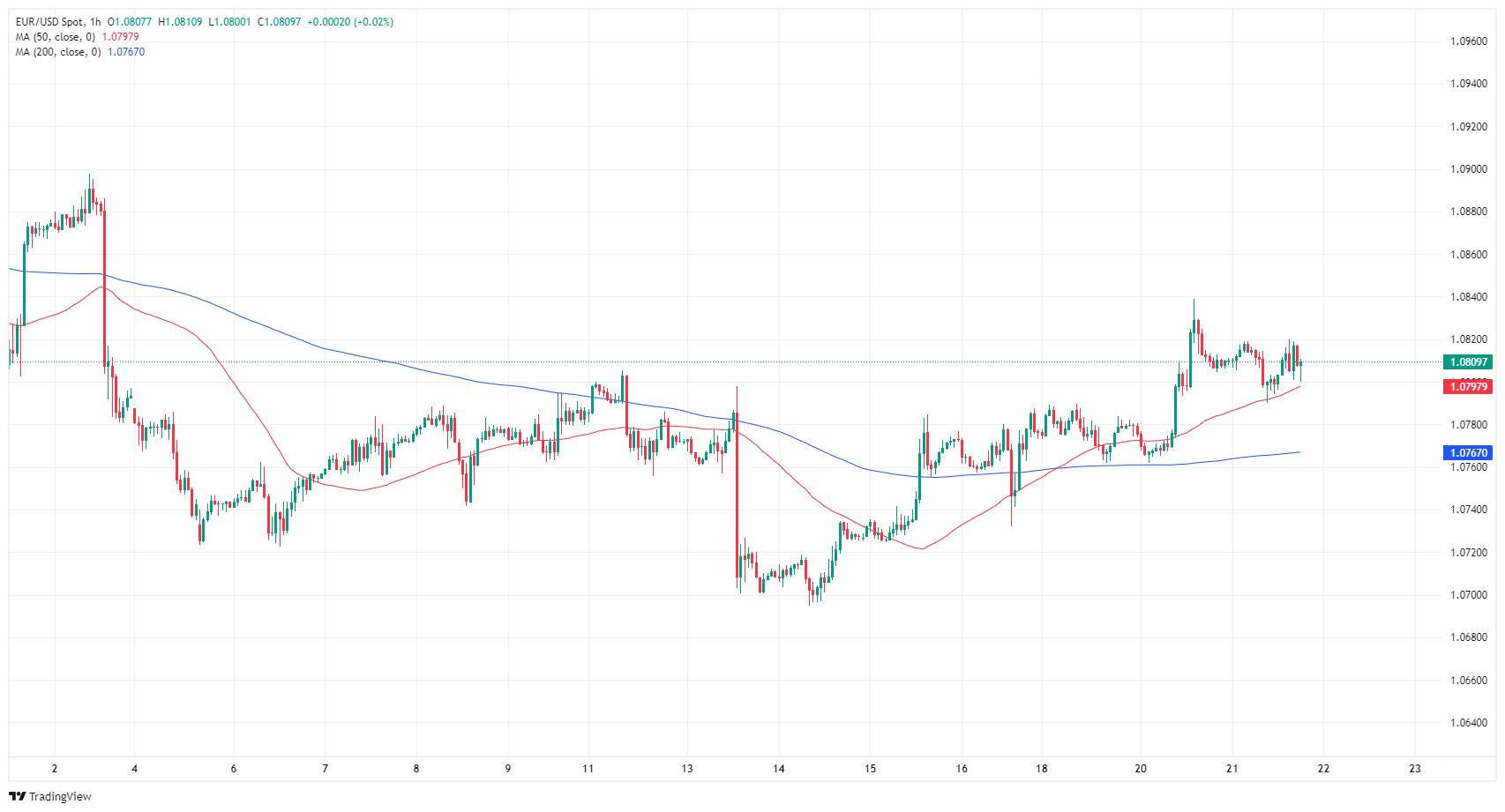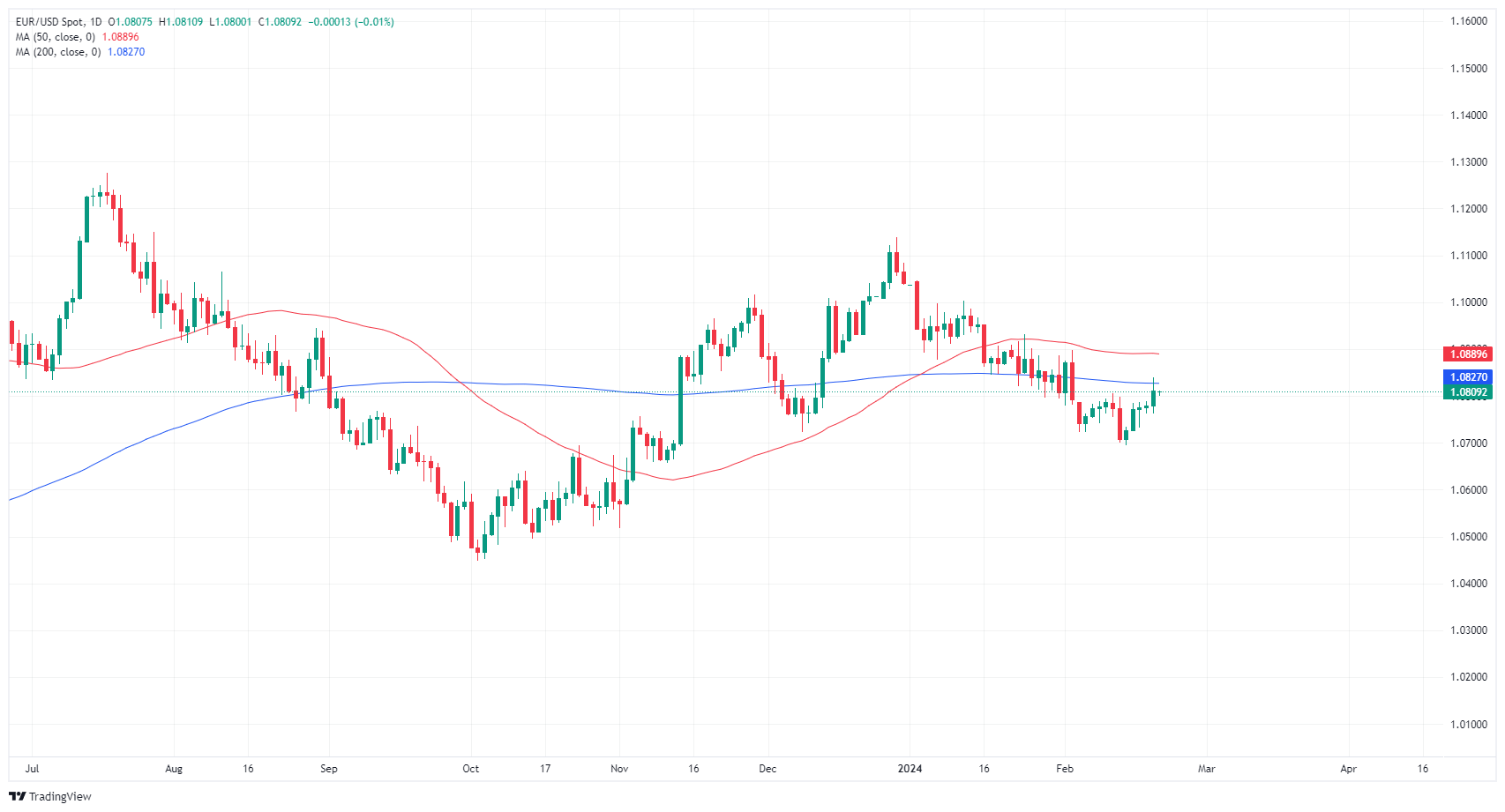EUR/USD softer ahead of Wednesday’s Fed Minutes release
- Market shuffles its feet as investors await latest Fed Minutes.
- EU and US PMIs slated for Thursday.
- Friday rounds out the trading week with a smattering of ECB speeches.
EUR/USD drifted into the midrange on Wednesday but is on the soft side as traders wait for the latest Federal Reserve (Fed) Minutes. It is unlikely that the Fed will deliver anything new for traders to chew on though. European and US Purchasing Managers Indices (PMIs) are slated for Thursday, where markets expect a slight improvement in the euro area and a softer print in US activity figures.
Friday wraps up the week with a smattering of speeches from policymakers from the European Central Bank (ECB). The Fed’s latest Monetary Policy Report also drops on Friday.
Daily digest market movers: EUR/USD pulls into the middle ahead of Fed Minutes
- The Fed’s Minutes from its last meeting will be poured over by investors looking for hints about how close the Fed is to cutting rates.
- The Fed still sees around three rate cuts this year, while money markets are still hoping for at least five, according to the CME’s FedWatch Tool.
- Markets are pricing in 70% odds of a first rate trim in June.
- Fed Minutes Preview: Traders await clues for rate outlook as expectations for cuts shift to second quarter
- The EU’s Consumer Confidence in February improved more than expected, printing at -15.5 versus the forecast -15.6, compared to the previous month’s print of -16.1.
- Thursday’s EU HCOB PMIs are broadly expected to recover, with the pan-euro area Composite PMI for February forecast to improve to 48.5 from 47.9.
- A below-50.0 print for the Composite component would represent a ninth straight month in contraction territory.
- Europe’s final Core Harmonized Index of Consumer Prices (HICP) inflation on Thursday is expected to confirm the preliminary print of 3.3% YoY.
- The US is expected to see a slight downtick in its PMI figures, with the Services component forecast to drop to 52.0 from 52.5 and the Manufacturing component expected to drop to 50.5 from 50.7.
Euro price today
The table below shows the percentage change of Euro (EUR) against listed major currencies today. Euro was the weakest against the Swiss Franc.
| USD | EUR | GBP | CAD | AUD | JPY | NZD | CHF | |
| USD | 0.02% | 0.03% | -0.07% | 0.20% | 0.24% | 0.00% | -0.16% | |
| EUR | -0.01% | 0.02% | -0.09% | 0.19% | 0.22% | -0.02% | -0.18% | |
| GBP | -0.03% | -0.01% | -0.10% | 0.17% | 0.22% | -0.03% | -0.18% | |
| CAD | 0.07% | 0.08% | 0.10% | 0.26% | 0.30% | 0.06% | -0.09% | |
| AUD | -0.19% | -0.19% | -0.18% | -0.29% | 0.04% | -0.22% | -0.37% | |
| JPY | -0.24% | -0.23% | -0.21% | -0.31% | -0.03% | -0.24% | -0.41% | |
| NZD | 0.01% | 0.02% | 0.04% | -0.07% | 0.20% | 0.23% | -0.15% | |
| CHF | 0.14% | 0.16% | 0.19% | 0.09% | 0.37% | 0.40% | 0.16% |
The heat map shows percentage changes of major currencies against each other. The base currency is picked from the left column, while the quote currency is picked from the top row. For example, if you pick the Euro from the left column and move along the horizontal line to the Japanese Yen, the percentage change displayed in the box will represent EUR (base)/JPY (quote).
Technical analysis: EUR/USD grapples with 1.0800
EUR/USD remains on the bullish side of the 200-hour Simple Moving Average (SMA) near 1.0767 as the pair drifts into the high end in the near term. Price action has continued to extend a rough recovery from last week’s dip into the 1.0700 handle, but halting momentum sees bullish sentiment beginning to thin at the intraday level.
Daily candlesticks have the pair knocking into the 200-day SMA near 1.0830, and topside momentum is facing a significant technical ceiling. The EUR/USD is still facing a pattern of descending highs, and the pair is still down around 3% from December’s peak bids near 1.1140.
EUR/USD hourly chart
EUR/USD daily chart
Euro FAQs
What is the Euro?
The Euro is the currency for the 20 European Union countries that belong to the Eurozone. It is the second most heavily traded currency in the world behind the US Dollar. In 2022, it accounted for 31% of all foreign exchange transactions, with an average daily turnover of over $2.2 trillion a day.
EUR/USD is the most heavily traded currency pair in the world, accounting for an estimated 30% off all transactions, followed by EUR/JPY (4%), EUR/GBP (3%) and EUR/AUD (2%).
What is the ECB and how does it impact the Euro?
The European Central Bank (ECB) in Frankfurt, Germany, is the reserve bank for the Eurozone. The ECB sets interest rates and manages monetary policy.
The ECB’s primary mandate is to maintain price stability, which means either controlling inflation or stimulating growth. Its primary tool is the raising or lowering of interest rates. Relatively high interest rates – or the expectation of higher rates – will usually benefit the Euro and vice versa.
The ECB Governing Council makes monetary policy decisions at meetings held eight times a year. Decisions are made by heads of the Eurozone national banks and six permanent members, including the President of the ECB, Christine Lagarde.
How does inflation data impact the value of the Euro?
Eurozone inflation data, measured by the Harmonized Index of Consumer Prices (HICP), is an important econometric for the Euro. If inflation rises more than expected, especially if above the ECB’s 2% target, it obliges the ECB to raise interest rates to bring it back under control.
Relatively high interest rates compared to its counterparts will usually benefit the Euro, as it makes the region more attractive as a place for global investors to park their money.
How does economic data influence the value of the Euro?
Data releases gauge the health of the economy and can impact on the Euro. Indicators such as GDP, Manufacturing and Services PMIs, employment, and consumer sentiment surveys can all influence the direction of the single currency.
A strong economy is good for the Euro. Not only does it attract more foreign investment but it may encourage the ECB to put up interest rates, which will directly strengthen the Euro. Otherwise, if economic data is weak, the Euro is likely to fall.
Economic data for the four largest economies in the euro area (Germany, France, Italy and Spain) are especially significant, as they account for 75% of the Eurozone’s economy.
How does the Trade Balance impact the Euro?
Another significant data release for the Euro is the Trade Balance. This indicator measures the difference between what a country earns from its exports and what it spends on imports over a given period.
If a country produces highly sought after exports then its currency will gain in value purely from the extra demand created from foreign buyers seeking to purchase these goods. Therefore, a positive net Trade Balance strengthens a currency and vice versa for a negative balance.

